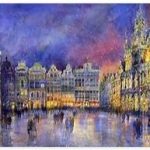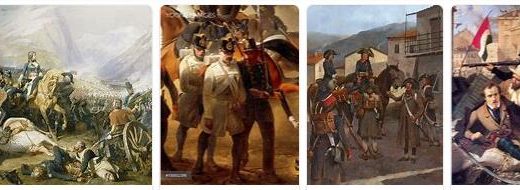Norway Arts
The first great artistic flowering of Norway dates back to the so-called migration period (5th-9th century), when the typically Nordic ornamental style was developed based on curvilinear and ribbon-like animalistic motifs of Scythian derivation; examples of this decoration can be found on buckles, sword handles, seals of the time. In the subsequent Viking period (ca. 800-1050) the most important centers of artistic production concentrated along the western coast of Norway and in the area around Oslo, as evidenced by the rich finds (9th century) of the tombs-ships of the chiefs Vikings, of which the most famous, that of Oseberg, includes a ship, a chariot, four sleds (all carved with zoomorphic motifs), weapons, jewels, fabrics. Continental (Carolingian) and insular decorative motifs, coming from the British Isles conquered by the Vikings, arrived in Norway in the 10th century. IX (brooch from the golden treasure of Hon with acanthus leaf motifs) while remaining subordinate to the characteristic Nordic decoration with stylized zoomorphic motifs. The conversion of Norway to Christianity consecrated the influence of European religious architecture, which was associated, according to original formulas, with the construction methods typical of the Nordic countries. Of the approx. 800 wooden churches (stavkirker) built in the sec. XI and XII (Norway is the only country in which few rare and magnificent examples have been preserved, to be exact 28), the first is that of Urnes (ca. 1050), with a wooden portal carved in the traditional repertoire zoomorphic, but combined with motifs of rings and intertwined ribbons typical of the decoration of the British Isles. These stave churches, which often bear a rich carving decoration on the portals and inside, reveal their derivation from the ancient Nordic assembly halls or from pagan temples, with a roof resting not on the walls but on a row of internal pillars. Next to the wooden churches, the first stone churches were erected, both with a single hall with a square choir, and with three naves (St. Mary of Bergen; Stavanger cathedral; Hamar cathedral; Gamle Aker church in Oslo), all of the century. XII, in which the influence of the Anglo-Norman style is felt. The Gothic styleit was established in the century. XIII with the cathedral of Trondheim and, in the field of civil architecture, with the Haakonshalle in Bergen and with the fortresses of Akershus near Oslo and Båhus (built by Haakon V, 1299-1319). Examples of Gothic art can also be found in fresco painting, spread by the masters of the Oslo and Bergen schools; in carpets (carpet with months at the Kunstindustrimuseet in Oslo, ca. 1180); in the sculptures, influenced by French and English models (sculptures from Trondheim Cathedral; portraits of King Magnus Lagabøter and his sons in Stavanger Cathedral, ca. 1300). Starting from the middle of the century. A period of decline began in the fourteenth century, which coincided with the prevailing Dutch and North German influence of the Hansa cities, evident in imported late Gothic works (such as the front panels of the churches of Ringsaker and Trondene). Only in the field of wood carving, goldsmithing, textiles, did the traditional Norwegian style survive for a long time, both the Viking and Romanesque ornamental style, and the Gothic figurative one. There is little evidence of the Renaissance, limited to military architecture (Rosenkrantz tower in Bergen, 1562-68), as Norwegian civil architecture continued to be wooden for a long time. The baroque forms appeared in the century. XVIII in churches and palaces (Bergen New Church, 1758; Oslo War School, 1751). In the painting of the century. The portrait prevailed in the seventeenth century, while in the following century, alongside portraiture, wall decoration also became popular (Mathias Blumenthal; Peter Aadnes). Visit thedresswizard.com for practical advice for your trip to Norway.
After 1814, impressive public buildings of neoclassical style were built, based on the Danish and German model (Royal palace of Oslo, by HD Linstow, 1824-48; University, by Ch. H. Grosch, 1841-52). Grosch himself, HE Schirmer and Alexis de Châteauneuf were the main exponents of the romantic current neo-Gothic. At the beginning of the twentieth century with A. Arneberg and M. Poulsson an anti-romantic reaction was established which, after 1920, was countered by the neoclassicism of G. Blakstad and H. Munthe Kasa. From the same years there were also the first affirmations of functional architecture, whose main representatives were F. Brynn, G. Eliassene, S. Ellefsen, Munthe Kasa himself, A. Bjercke. After the war, with the establishment of the CIAM Norwegian (1950), architecture developed by addressing the problems associated with industrialization and trying to adapt traditional materials (stone, wood) to the most advanced techniques, in harmony with environmental conditions. Norwegian painting in the nineteenth century was closely linked with German. The forefather of landscape painting, JC Dahl, was active in Dresden in contact with CD Friedrich. A. Cappelen, H. Gude, L. Hertevig, L. Munthe, A. Nielsen, A. Tidemand all belong to the Düsseldorf school, while after 1870 Munich was rather the pole of attraction for young Norwegian painters. Around 1880 many artists adhered to French naturalism: Ch. Krohg, main exponent of Norwegian realism, H. Backer, E. Werenskiold, F. Thaulow, but closer to the modes of impressionism. At the beginning of the twentieth century a lively reaction to naturalism in an expressionistic and symbolistic sense came from a group of artists (G. Munthe, H. Egedius, L. Karsten, H. Sørensen) of which the most significant is E. Munch (1863- 1944). The Cubist experience later found wide acceptance, mediated through the Danish G. Jacobsen (A. Revold, LP Krohg, A. Rolfsen). In the field of modern sculpture we should remember S. Sinding (1846-1922) and G. Vigeland (1869-1943), original portraitist oriented towards expressionism; among those of subsequent generations, GT Janson (1901-1983), F. Fredriksen (1902-1977), O. Bast (1907-1974), A. Gunnerud (b. 1930) and A. Haukeland (1920-1983), exponent of the non-figurative current. The ‘ abstract expressionism and constructivism have significant exponents in J. Weidemann painters, GS Gundersen, G. Groth, who by the end of the eighties has also produced sculptures. The surrealism, which also did not find wide correspondence in Norwegian art, had its major representative in K. Rose. The work of J. Doubloug (b. 1945) is linked to German expressionism and to the painting of W. de Kooning; that of A. Pettersen (b.1943) finds its deepest inspiration in the art of Matisse, while the expressionist component is flanked by a naive tendencyT. Hansen (b. 1949). In the field of sculpture, the most prominent figure of recent decades is undoubtedly B. Breivik (b.1948), but S. Tolaas (b.1959), PI Bjorlo (b.1952), S. Sokke (b.1952), P. Barclay (b.1955) and K. Johannessen (b.1960). In addition, important exponents of the new trends in Norwegian sculpture, with works of art that lie between sculpture and installations, are J. Gundersen (b.1942), famous for his works based on waste recycling, K. Olsen (b.1952) using metal and the irreverent K. Slettemark (b.1932).
The architecture of Norway reflects both the historical events of the country where the long domination of Denmark limited the development of a dominant economic class and marginalization with respect to international architectural movements, and the salient characteristics of its very Nordic and sparsely inhabited territory. The arrival of Christianity led to the construction of several churches in stone, even if the ancient tradition of wooden constructions maintained its supremacy, also given the abundance of the precious raw material. In architecture, which in the second half of the nineteenth century was mostly based on German models, at the beginning of the twentieth century a more specifically national current was established aimed at rediscovering the Norwegian past, worthily represented by ancient tradition of wooden constructions maintained its supremacy, also given the abundance of the precious raw material. In architecture, which in the second half of the nineteenth century was mostly based on German models, at the beginning of the twentieth century a more specifically national current was established aimed at rediscovering the Norwegian past, worthily represented by A. Arneberg (1882-1961), M. Poulsson (1881-1958), JO Nordhagen (1883-1925). Especially the 1930s, dominated by functionalism, proved to be very productive. Modern architecture has as its most significant exponents in H. Munthe-Kaas (1890-1977), L. Backer (1829-1930), O. Bang (1895-1942). The most prominent personalities of the second post-war period are A. Korsmo (1900-1968) and K. Knutsen (1903-1969), also active in the field of design (revalued in recent years also at an international level, especially in the sector of the furniture), which influenced the training of the younger generation of architects (S. Fehn, K. Lund, N. Slaatto, NH Eggen). The post-modernism of the Eighties, born in reaction to the supposed lack of expressiveness of modernism, was experienced as the possibility of a new creative freedom by its protagonists who centered their attention also on details of greater instinct, often with the intention of integrate the styles of the past with the thrust towards the future. But the modernist roots returned strongly after a decade in the sober and geometric forms of the buildings of the 1990s, at the end of which a small Norwegian architecture studio, Snøetta, unexpectedly won the competition announced by the Egyptian state for the design of the new library in Alexandria.. The new building, majestic and simple, inaugurated in 2002.









